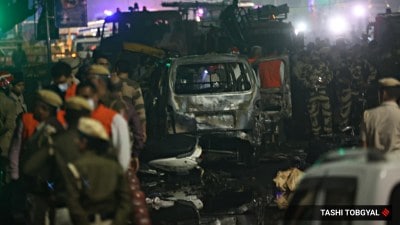Delhi sees coldest morning of the season at 10.4 degrees Celsius, air quality ‘very poor’
The IMD’s historical data for the first 10 days of November over the past several years shows that this year has witnessed an unusually sharp and early drop in night temperatures.
 The daily average air quality index or AQI was recorded at 362 in the 'Very Poor' category, according to the Central Pollution Control Board (CPCB).
The daily average air quality index or AQI was recorded at 362 in the 'Very Poor' category, according to the Central Pollution Control Board (CPCB).Delhi on Monday saw its coldest morning of the season with the minimum temperature settling at 10.4°C — 3.9°C below the season’s normal. According to the India Meteorological Department (IMD), this is the first time this season when the mercury has dropped to around 10°C.
The daily average air quality index or AQI was recorded at 362 in the ‘Very Poor’ category, according to the Central Pollution Control Board (CPCB). As per the pollution watchdog, only the monitoring station at Bawana reported severe AQI at 411 on Monday, as of 9 pm. Other stations, such as Wazirpur, closely followed at 400 just a notch below being marked in the ‘Severe’ range.
Sharpest November dip in several years
The IMD’s historical data for the first 10 days of November over the past several years shows that this year has witnessed an unusually sharp and early drop in night temperatures. From 19.4°C on November 1, the minimum temperature has fallen almost steadily each day to 12.7°C by November 6, 11°C on November 8, and finally 10.4°C on November 10. This marks a fall of about 9°C in just 10 days, making it one of the steepest declines at the beginning of this month in recent years. By contrast, during the corresponding period last year, Delhi’s minimum temperature hovered between 17°C and 18°C, showing almost no decline through the first half of the month.
The situation was similar in 2022 and 2023, when the night temperature stayed well above 14°C until mid-November.
Only in 2020, when temperatures touched around 10°C in the first week was there a comparable early chill. Between 2021 and 2024, Delhi had seen a trend of delayed or gradual onset of winter, with relatively warm first halves of November.
According to experts, this year’s sharper drop can be attributed to clear skies, dry northwesterly winds, and reduced humidity, which together can enhance radiational cooling during the night.
On Monday, the IMD said in its bulletin, “Westerly winds prevailed with wind speed up to 15 kmph in the past 24 hours over Delhi.”
Meanwhile, the maximum temperature was also recorded two notches below normal at 27.5°C.
As per the IMD forecast, mainly clear skies are expected with mist or haze conditions in the morning hours this week. A few days will also see shallow fog conditions, it has said.
It has further forecast the minimum temperatures to hover to around 9-11°C by Friday. The maximum temperature is expected to hover around 26-28°C.
Drop in farm fire incident
The Commission for Air Quality Management (CAQM) National Capital Region and Adjoining Areas on Monday said it has been enforcing targeted statutory directions to curb emissions from key sectors in the area. “All inter-city buses plying to Delhi from NCR states have been transitioned to cleaner modes (EV/ CNG/ BS-VI diesel)…. and the entry of BS-III and below commercial goods vehicles (HGVs, MGVs and LGVs) into Delhi has been banned with effect from November 1, 2025, except those registered in Delhi,” it said.
It also added that there has been a decline in farm fire incidents in Punjab and Haryana. “…Punjab recorded 4,062 fire events as against 6,266 (i.e. 35.2% decline) during the corresponding period in 2024, while Haryana registered only 333 fire counts this year compared to 959 (65.3% decline) witnessed during the corresponding period of last year,” it said.
The Commission said it “is actively reviewing the on-ground situations with senior officers of the state governments of Punjab and Haryana and other concerned agencies to ensure strict implementation of statutory directions and to tackle the issue of stubble burning.”
Taking stock of the AQI reaching the upper end of the ‘Very Poor’ category on Sunday, the CAQM had decided not to evoke Stage III of the Graded Response Action Plan. It noted an “improving trend” in the air quality in the later half of the day.
From January 1, 2026, only CNG and electric three-wheeler auto rickshaws will be allowed in aggregator and delivery fleets.
On Monday, CAQM noted that “over 96% of industries” have shifted to approved fuels, with a dedicated Online Continuous Emission Monitoring System Cell monitoring stack emissions and “1,556 non-compliant units” ordered shut after inspections. In the construction sector, “over 6,000 construction sites were registered and more than 30,000 inspections carried out across NCR” in 2025, resulting in closure or penalty action against over 250 sites.







